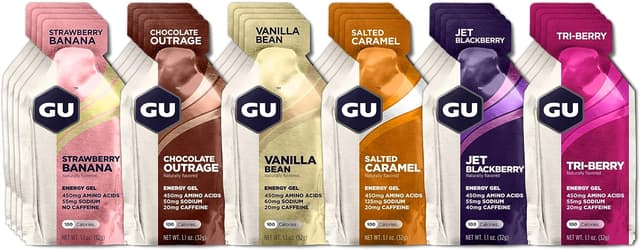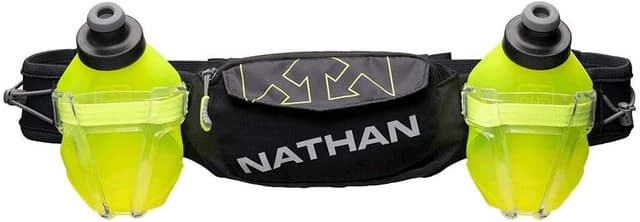Noah Brier | September 2, 2020
Why is this interesting? - The Running Edition
On exercise, growth, and miles covered
Recommended Products

A pack of energy gels designed for endurance athletes, to be consumed 40 minutes apart during long activities for sustained energy.

A running belt with a water bottle holder, designed for distance runners to carry water and essentials.
Noah here. Back in March, right before lockdown began, I bought a pair of running shoes. I had some clue that I wouldn’t be returning to the gym anytime soon, and figured it was a good time to try an alternative to my regular exercise routine. A carefully chosen pair of shoes, I hoped, would help solve some of the pains I had experienced in past attempts to get started running. The store associate put me through the regular paces—measurement, gait analysis, and the like—and sent me on my way with a new pair of Sauconys. As we settled into quarantine, I started to venture out for runs: short and slow at first, but picking up in pace and distance as I realized I enjoyed it. Despite the advice of every friend I spoke to and every article I read, I ran nearly every day for those first two weeks. It was the back half of March, and the only time I felt sane was for the 30 minutes a day I was out running. It was a chance to get some fresh air, raise my heart rate, clear my mind, and survey the state of Brooklyn.
Not surprisingly, I hurt myself. The advice to ease into running turns out to be well-founded—at least for me—as I didn’t yet have the experience to know when to take a break. Thankfully I hadn’t done too much damage and hit the streets again after a week’s break. In that time, I read up on recovery, as well as stride and heart rate pacing, and made some adjustments to ensure I didn’t more seriously hurt myself next time. My new routine was a run every other day, which I slowly stretched to four, five, and six miles. The exercise was addictive, but so was the progress and stretches of time on my own.
Why is this interesting?
This week I will pass 500 miles in 2020. Lots of runners put far more distance down in a six-month span, but this was a completely unimaginable number for me when I first laced up my new running shoes just a few months ago. To celebrate the occasion, I thought I’d write up some of what I’ve learned and observed as I’ve added running to my life. Until now I haven’t written much about running because I am acutely aware of my lack of expertise, so all I ask is that you don’t read this as any kind of advice or admonishment, but rather a personal journey. And if you’re a runner with more experience who spots a mistake or has advice, I’m all ears.

Illustration courtesy of Edith Zimmerman’s excellent Drawing Links newsletter
The two areas that have most captured my interest are tightly interconnected: heart-rate and distance. Although I’ve found it reasonably hard to track down good answers on precisely how to interpret heart-rate data—the whole fat-burning zone, for instance, seems like mostly nonsense—the basics are pretty simple. Your heart is a very good barometer of your effort. It’s a little like your body’s engine. As you ascend a hill, you have a choice: go slower and exert the same effort or keep your speed constant and push your heart rate higher. One of the amazing things about watching your heart rate during runs is that it always tells you the truth. Even when it doesn’t feel like I’m working particularly hard on a climb, a rising heart rate gives away the effort. I monitor everything on my Apple Watch, which despite arguments to the contrary by serious athletes, is by all accounts a plenty accurate HR monitor for most of us (+/- 1.5 beats-per-minute vs. chest straps).
Over many miles watching my beats-per-minute rise and fall, I have learned how to use it as a barometer for my body. It’s taught me about the effects of temperature/humidity and the importance of hydration after I had to bail on a very hot day when my heart rate held steady above my normal range. It’s taught me to pace myself better, particularly on long runs, when I saw that I could make it much further if I kept my heart rate low, especially for the first few miles. But mostly, it’s taught me how to understand that my feelings of effort—faster speeds and harder breathing—were translating to heart effort and that I should trust the signals I’m feeling as much as the ones I’m seeing on my watch. I still check my wrist often, but it seldom tells me something surprising. And as my eyes move from heart rate to pace, the two are nearly always inline.
Most importantly, to me at least, understanding my heart rate (and pace) has allowed me to extend the distance I run. What started as a mile-and-a-half in March extended to 15 miles in August. And while I’ve had a few folks tell me I’ve ramped things up too quickly, I’ve also taken great care not to overextend myself after those first two weeks.
What’s surprised me most is how much I’ve come to enjoy the long runs, to the point where going out for just a few miles seems like far more of a chore than getting into the double digits. I’ve spent a lot of time trying to dissect this on runs and with friends, and as best as I can tell, it comes down to a few different factors.
First, the excitement. For me, a long run still comes with some jitters about whether I can make it or not, and that feeling of the managed unknown is fun, particularly in a moment where there are so many unmanaged unknowns we are all dealing with day-to-day.
Second, the commitment. There’s a difference between driving across town and driving cross-country. The latter comes with a knowledge that you’re in for a long haul, and usually comes with plans for entertainment, nourishment, and anything else you might need to make the trip as comfortable as possible. Although you know you’ve got many hours in the car, it’s easier to feel patient when it’s what you signed up for. You can settle in, get comfortable, and just enjoy the ride. Long runs feel that way to me. I usually have a planned route, plenty of water, some gels, and two Michael Mayer mixes queued up. Even when I don’t know precisely where I’m going, I still know I’ll be out for a few hours.
Finally, there’s the routine. I covered this extensively in The Routine Edition, but I really enjoy keeping things consistent. Much has been written about how routines can ease the burden of decision making, but they also just bring us comfort. When I’m out on the weekend, I bring three gels with me that are meant to be consumed 40 minutes apart. At each 30 minute mark, I take one out of the velcro pocket of my pouch (when I’m out for distance I wear a water bottle fanny pack thing) and transfer it to my shorts pocket, so it’s ready to go. When the time comes, I rip the top off, put the garbage in my pocket, and slurp the goo down. After I’m done, I return both the packet and top strip to the zippered section of my pack and chase it down with a little drink of water. Writing it all down, it sounds kind of crazy, but if you’re out by yourself doing nothing but running for a few hours, what do you have to do but invent elaborate rituals like this? It’s a small achievement that keeps me moving over many miles.
In May, I set a goal to run a half marathon distance by the end of the summer. Since then, I’ve passed that mark eight times. I don’t really have a new running goal for now. I’m just enjoying being out, pushing myself, and figuring things out. (NRB)
Newsletter of the Day:
Today’s edition is partly a result of a walk and talk about running with WITI contributor Edith Zimmerman. A bunch of us started running around the same time in late-March and we’ve all been sharing progress along the way on Slack and Strava. Edith’s newsletter, Drawing Links, has captured her deep dive into running (she blew past 500 miles run this year a long while ago) amongst a wonderful mix of other topics. Every email is a favorite read. (NRB)

Quick Links:
From WITI contributor Daniel Oberhaus, Are Radioactive Diamond Batteries a Cure for Nuclear Waste? (NRB)
On topic for today from McSweeney’s: Is This How Running Is Supposed To Feel? (NRB)
Thanks for reading,
Noah (NRB) & Colin (CJN)
PS - Noah here. Variance, my new company, is just getting going with our Alpha. If you work in sales, services, marketing, or engineering and want to try out/give feedback on a tool to help your team work more effectively with their apps, please request an invite on the site. Thanks.
—
Why is this interesting? is a daily email from Noah Brier & Colin Nagy (and friends!) about interesting things. If you’ve enjoyed this edition, please consider forwarding it to a friend. If you’re reading it for the first time, consider subscribing (it’s free!).